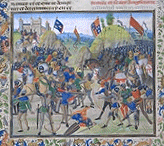 English Longbowmen against crossbows (95K JPG)
English Longbowmen against crossbows (95K JPG)
Picture courtesy of Bibliotheque Nationale, Paris
 English Longbowmen against crossbows (95K JPG)
English Longbowmen against crossbows (95K JPG)
Picture courtesy of Bibliotheque Nationale, Paris
In 1337, based on the strength of his claim to the French throne as a direct descendant of Philip IV
through his mother, Isabella of France, Edward III of England refused to do more than
simple (non-liege) homage for Guyenne to the French King Philip VI.
The resulting war that started shortly afterward between France and England continued,
with periodic truces, until 1453.
![[Map of France]](france.gif) The Battle of Crécy, fought on Saturday, August 26, 1346 was the first of several significant battles
during which the longbow triumphed over crossbowmen and armoured knights.
The Battle of Crécy, fought on Saturday, August 26, 1346 was the first of several significant battles
during which the longbow triumphed over crossbowmen and armoured knights.
(Other battles were
Poitiers, in 1356 and Agincourt, in 1415.)
Some highlights of the battle of Crécy - referenced from the works of Jean Froissant and The Longbow by Robert Hardy:
| It was during Edward's taking of Caen, on the way to Crecy, that the "mooning" incident occurred. Several hundred Norman soldiers exposed their backsides to the English archers and many of them paid a high price for doing so. |